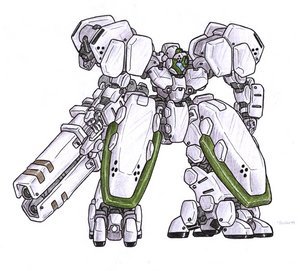Neuromancer
From Gwn
| Neuromancer | |

| |
| Model Type: | LaGrange Point Council |
| Pilot System: | Torvald Interface |
| Construction: | Gundanium Alpha Alloy |
| Date Built: | September 9, AC 255 |
| Date Destroyed: | |
| Height: | |
| Weight: | |
| Design Features: | "Torvald" Interface |
| Weaponry: | * 2x Calf-Mounted Micro-Missile Batteries
|
| Pilots: | Matthew Burroughs |
The Neuromancer is the first true Gundam produced by the LGPC. Designed specifically to Commander Burroughs specifications, including it's customized "Torvald" interface, the Neuromancer is designed to fight effectively at a distance as well as in close-range combat, though it's defense systems and speed are slightly lacking when compared to other Gundams.
Design Features
Custom Implemented Interface - "Torvald" pattern - The Torvald interface replaces an MS's standard control scheme with three Dvorak-patterns keyboards, one directly in front of the pilot's chair and one to either side. The central keyboard uses the standard, two-handed key layout, while the other keyboards are designed to be used one-handed, patterened to either the left or right hand respectively. Above each keyboard is a small monitor connected to a small hard drive that in turn runs into the main hardware of the suit. Each of these subsystems allow the user to gain more direct access to the internal systems of the MS itself. The standard, large cockpit monitors remain in place, but can be controlled esasily via the new keyboard interface.
The main (center) system and the secondary (right) systems utilize a modified version of the Slackware Linux distribution, whilst the management (left) system, which is used to control interaction between the other two systems and the MS itself, runs EnGarde Secure Linux and acts almost like an administrative server system. The current version of the Torvald interfact utilizes only CLI components, and there are no plans for GUI implementation any time in the near future. This requires that the user have intrinsic knowledge of both Unix commands and of the inner workings of the MS OS in order to effectively control a suit with the Torvald interface installed. In case of emergency, the standard MS control configuration is installed in the roof of the cockpit, and can be swung into place in a few seconds should the need arise.
The most useful element of the Torvald interface is it's advanced scripting capabilities. Rather than controlling the suit through simple, direct commands (which is entirely possible, though sometimes impractical, with this interface), the user can access a large library of pre-written program scipts that instruct the suit to follow a certain behavioral pattern until the program's terminating condition is met, a new script overrides the behavior, or the user manually terminates the program. The user can also write custom scripts on the fly and feed them into the system, allowing for even more dynamic control of MS behavior. New hardware that is installed on the MS can be modified to operate within the system, so that the user maintains control of all aspects of their suit's functionality.
The most powerful aspect of this system is that the user can run several scripts at once and still maintain basic control over their suit. For example, a user might have a script running that fires a missile system at all targets that come within a certain range, a script that gives the user a warning message on one of the main monitors, and a script that will deactivate all scripts that are currently running upon a simple command argument from the user, while the user maintains direct control over the suit's beam rifle. The system makes multi-tasking much easier, but puts more mental stress on the user than a normal MS, as the pilot has to keep track of both the battle itself and all the scripts they are trying to coordinate. The Torvald system also requires the user to have a specific knowledge of all the associated functions and how to manage and write the program scripts that are essential to the suit's operation.
